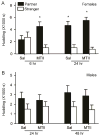Neonatal melanocortin receptor agonist treatment reduces play fighting and promotes adult attachment in prairie voles in a sex-dependent manner
- PMID: 24923239
- PMCID: PMC4158739
- DOI: 10.1016/j.neuropharm.2014.05.041
Neonatal melanocortin receptor agonist treatment reduces play fighting and promotes adult attachment in prairie voles in a sex-dependent manner
Abstract
The melanocortin receptor (MCR) system has been studied extensively for its role in feeding and sexual behavior, but effects on social behavior have received little attention. α-MSH interacts with neural systems involved in sociality, including oxytocin, dopamine, and opioid systems. Acute melanotan-II (MTII), an MC3/4R agonist, potentiates brain oxytocin (OT) release and facilitates OT-dependent partner preference formation in socially monogamous prairie voles. Here we examined the long-term impact of early-life MCR stimulation on hypothalamic neuronal activity and social development in prairie voles. Male and female voles were given daily subcutaneous injections of 10 mg/kg MTII or saline between postnatal days (PND) 1-7. Neonatally-treated males displayed a reduction in initiated play fighting bouts as juveniles compared to control males. Neonatal exposure to MTII facilitated partner preference formation in adult females, but not males, after a brief cohabitation with an opposite-sex partner. Acute MTII injection elicited a significant burst of the immediate early gene EGR-1 immunoreactivity in hypothalamic OT, vasopressin, and corticotrophin releasing factor neurons, when tested in PND 6-7 animals. Daily neonatal treatment with 1 mg/kg of a more selective, brain penetrant MC4R agonist, PF44687, promoted adult partner preferences in both females and males compared with vehicle controls. Thus, developmental exposure to MCR agonists lead to a persistent change in social behavior, suggestive of structural or functional changes in the neural circuits involved in the formation of social relationships.
Keywords: Early experience; Melanocortin receptor; Melanotan-II; Oxytocin; Prairie voles; Social behavior.
Copyright © 2014 Elsevier Ltd. All rights reserved.
Figures






References
-
- Acker GR, Berran J, Strand FL. ACTH neuromodulation of the developing motor system and neonatal learning in the rat. Peptides. 1985;6(Suppl 2):41–49. - PubMed
-
- Alvaro JD, Tatro JB, Duman RS. Melanocortins and opiate addiction. Life Sci. 1997;61:1–9. - PubMed
-
- Alvaro JD, Tatro JB, Quillan JM, Fogliano M, Eisenhard M, Lerner MR, Nestler EJ, Duman RS. Morphine down-regulates melanocortin-4 receptor expression in brain regions that mediate opiate addiction. Mol Pharmacol. 1996;50:583–591. - PubMed
Publication types
MeSH terms
Substances
Grants and funding
LinkOut - more resources
Full Text Sources
Other Literature Sources

